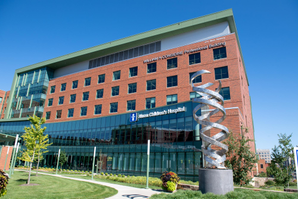Upper Extremity Motion Analysis Lab
Back to Hand and Upper Extremity Clinic

Akron Children’s has the only motion analysis lab in the region dedicated to evaluating the movement and function of the upper extremities, including arms, shoulders, elbows, wrists and hands. It is used to specific joint movements and can be helpful for assessing movement as a child grows, optimizing surgical plans, and evaluating treatment outcomes.
Learn more...About Motion Analysis Lab
In the motion analysis lab, small sensors are attached to your child’s arms and torso to record movements in 3D. This technology picks up subtle changes in movement, including ways your child may be modifying how they move to compensate for limitations. Similar technology is used in computer-generated imagery (CGI) in movies and video games.
This assessment will help guide a treatment plan to maximize your child’s functioning. For surgical patients, there will be a post-surgery assessment measure improvement and determine if further treatment is needed.
The motion analysis lab is also involved in multiple research studies to learn more about arm movement throughout development in typical kids, as well as kids with conditions affecting how their arms move.
Orthopedics, Akron
Akron Children's Orthopedics, AkronConsidine Professional Building
215 West Bowery Street
Level 7
Akron, Ohio 44308
Fax: 330-543-5001
Map & directions
More about this location...
Appointments: 330-543-2778
Department: 330-543-3500
Open Clinical Studies
Assessment of reachable workspace in patients undergoing elbow or shoulder surgery
Use of markers with motion capture to see the space patients can reach with their hands before and after undergoing elbow or shoulder surgery.
More about this studyAssessment of reachable workspace in patients with Brachial Plexus (BP) or Cerebral Palsy (CP)
Use of markers with motion capture to see the space patients can reach with their hands to discover deficits in patients with Cerebral Palsy or Brachial Plexus.
More about this studyMotion Capture to Assess Function of Upper Extremities in Typically Developing Children
The study will use reflective markers that track movements to assess how children with no current injuries or health conditions can position and move their arms.
More about this studyReachable Workspace
Reachable workspace is a measure of how far a person can reach in space with their hand. It is used to measure the mobility and reach of the arm as a whole. We use real-time feedback to engage patients in a collection of reachable workspace data to develop a treatment plan.
Motion Capture
Motion capture can be used to measure specific joint motions. For example, shoulder motion is made up of movement from both the shoulder blade (scapulothoracic) and the upper arm (glenohumeral). These can be separately measured using the 3D motion capture system.
Conditions and Treatments:
Brachial plexus injuries, shoulder injuries, cerebral palsy















